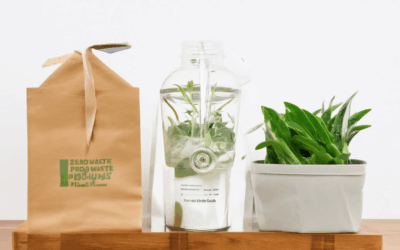Are you looking to transform your kitchen into a more sustainable and healthy space? Eco-friendly kitchen products are becoming increasingly popular, offering both environmental and health benefits. By choosing products that minimize waste and reduce chemical exposure, you can create a kitchen that’s as good for the planet as it is for your family. Whether you’re aiming for a zero-waste lifestyle or simply looking to make small, impactful changes, there’s a wide range of eco-friendly options to explore. From reusable utensils to natural cleaning products, discover how simple it can be to adopt a more sustainable mindset in your daily routine. This guide will walk you through the best eco-friendly kitchen products, tips for reducing waste, and how to incorporate sustainable practices into your cooking and cleaning habits.
Key Takeaways
– Eco-Friendly Products Reduce Environmental Impact: Focus on sustainable materials and practices to minimize harm to the planet.
– Plant-Based Alternatives Lower Carbon Footprint: Choose tofu, almond milk, and whole grains for healthier and more resource-efficient options.
– Sustainable Sourcing Promotes Fairness and Biodiversity: Opt for Fair Trade certified and organic products to support ethical practices and preserve natural habitats.
– Innovative Packaging Minimizes Waste: Use biodegradable and compostable materials to reduce plastic use and contribute to soil health.
– Reusable and Zero-Waste Products Lead the Way: Prioritize items like reusable water bottles and refillable containers to cut down on single-use waste.
– Sustainable Eating Reduces Your Carbon Footprint: Select plant-based proteins, whole grains, and locally-sourced foods to minimize transportation emissions.
– Support Ethical Brands for Maximum Impact: Choose companies with strong environmental track records to align your values with your purchases.

What Are Eco-Friendly Kitchen Products?
Eco-friendly kitchen products are items designed to minimize environmental impact while performing everyday tasks in the kitchen. These products focus on sustainability, reducing waste, and promoting healthier living.
- Bio-degradable Sponges : Replace traditional sponges with plant-based, bio-degradable options that break down quickly and don’t harm water systems.
- Reusable Kitchen Towels : Opt for washable and durable towels made from organic materials instead of disposable ones, saving trees and reducing plastic waste.
- Non-Toxic Cleaning Supplies : Choose cleaning products free from harmful chemicals that can harm the environment and your health. Look for plant-based or natural alternatives.
- Compostable Trash Bags : Use compostable bags made from renewable materials to dispose of food scraps and reduce landfill waste.
- Sustainable Cutting Boards : Select cutting boards made from bamboo, wood, or recycled materials instead of plastic or metal, which can be harmful to wildlife.
- Eco-Friendly Dishware : Use dishes, utensils, and cookware made from biodegradable or recyclable materials to reduce energy consumption during washing and recycling.
- Energy-Efficient Appliances : Invest in Energy Star-rated appliances like refrigerators, microwaves, and ovens to save energy and lower your carbon footprint.
- Recycled Glassware : Use glass containers that have been recycled to store leftovers or drinks, minimizing plastic use and supporting the circular economy.
- Natural Cleaning Scrubs : Make your own cleaning scrubbers using ingredients like baking soda, vinegar, and essential oils instead of harsh chemical cleaners.
- Herb Gardens : Grow your own herbs and spices in small pots or window boxes to freshen up your cooking without packaging waste.
How Can I Make My Kitchen Eco-Friendly?
Transforming your kitchen into an eco-friendly space involves several thoughtful changes that promote sustainability and reduce your environmental impact. Here are some practical steps to get started:
1. Reduce Waste
- Composting: Start a compost pile in your backyard or use a small bin indoors for kitchen scraps. This transforms waste into nutrient-rich soil.
- Reusable Products: Invest in reusable cloth napkins, beeswax wraps, and glass containers to replace disposable items.
- Recycling: Use separate bins for recyclables and ensure your household properly separates materials for efficient processing.
2. Energy Efficiency
- Cook Smarter: Use lids on pots and pans to retain heat and reduce cooking time, lowering energy consumption.
- Appliance Efficiency: Replace old appliances with energy-efficient models, looking for the ENERGY STAR label to identify optimal choices.
- Lighting: Switch to LED lights for your kitchen, as they consume less energy and last longer than traditional bulbs.
3. Water Conservation
- Low-Flow Fixtures: Install water-saving faucet aerators and low-flow showerheads to reduce water usage during tasks like washing dishes.
- Water Filter: Use a filtered water tap to eliminate plastic bottle waste and enjoy clean drinking water straight from your sink.
- Efficient Habits: Run water only when needed, such as while scrubbing dishes, to conserve resources.
4. Eco-Friendly Cleaning
- Natural Cleaners: Create your own cleaning solutions using vinegar and baking soda, which are cost-effective and safe for the environment.
- Sustainable Sponges: Choose biodegradable sponges made from plant-based materials instead of synthetic ones.
- Reusables: Use washable cloths and reusable containers for food storage to minimize single-use plastics.
5. Sustainable Purchases
- Local Produce: Support local farmers by purchasing fruits, vegetables, and meats at farmers’ markets or through Community Supported Agriculture (CSA) boxes.
- Seasonal Goods: Buy produce that’s in season to reduce transportation emissions and enjoy fresher flavors.
- Bulk Purchases: Bring your own containers to local stores for bulk buys, reducing plastic packaging waste.
6. Reduce Food Waste
- Meal Planning: Create a meal plan to minimize leftovers and ensure you use ingredients before they spoil.
- Storage Solutions: Use airtight containers and root vegetable storage to keep foods fresh and reduce waste.
- Composting Again: Don’t let kitchen scraps go to waste; compost them to enrich your garden or plants.
7. Natural Cleaning Methods
- Herbs and Oils: Use thyme, rosemary, or eucalyptus oil as natural air fresheners and disinfectants.
- DIY Cleaners: Mix baking soda, vinegar, and essential oils to create effective cleaning solutions.
- Dry Clothes: Hang clothes outside to air dry, reducing reliance on energy-hungry dryers.
By implementing these eco-friendly practices, you’ll create a kitchen that’s not only sustainable but also more efficient and healthier for your family. Small changes can lead to significant impacts on the environment.

What is a zero waste kitchen?
A zero-waste kitchen is an approach to cooking and meal planning that minimizes food waste and focuses on sustainability. Here’s a breakdown of the key aspects:
- Reduce Food Waste :
- Plan meals carefully to avoid overbuying or throwing away food.
- Use tools like meal planners or apps to track ingredients and prevent waste.
- Store leftovers properly to extend shelf life.
- Composting :
- Collect organic scraps (peels, banana peels, coffee grounds) and compost them to reuse as fertilizer.
- Consider getting a compost bin or worm farm to manage kitchen scraps effectively.
- Recycling and Upcycling :
- Separate recyclable materials like glass, plastic, paper, and metal.
- Repurpose items like jars, bottles, or cardboard for storage or crafts.
- Shop Local and Sustainable :
- Buy seasonal, local produce to reduce transportation emissions and support local farmers.
- Choose sustainable products like eco-friendly packaging or bulk goods.
- Cook in Bulk :
- Prepare larger quantities to minimize waste from small portions.
- Use frozen or canned ingredients when fresh isn’t available.
- Minimize Single-Use Items :
- Use reusable containers, cloth napkins, and eco-friendly cleaning products.
- Avoid single-use plastics and disposable items.
The benefits of a zero-waste kitchen extend beyond the environment:
- Financial Savings : Reduce food waste and lower grocery bills.
- Environmental Impact : Minimize landfill waste and conserve resources.
- Better Nutrition : Prioritize whole foods and reduce exposure to processed goods.
- Circular Economy : Repurpose and extend the lifecycle of products.
By adopting these practices, you can create a kitchen that’s both efficient and environmentally conscious. For more tips and resources, visit our sustainable living guide .

What Are Eco-Friendly Food Products?
Eco-friendly food products are items that minimize harm to the environment while meeting basic human needs. These products often focus on sustainability, reducing waste, and promoting healthier lifestyles. Here’s a breakdown of key categories:
1. Plant-Based Products
- Meat Alternatives : Products like tofu, tempeh, and seitan are rich in protein and have a lower carbon footprint compared to traditional meats.
- Dairy Alternatives : Almond milk, oat milk, and coconut milk are excellent substitutes for dairy, reducing the demand for industrialized dairy farming.
- Grains : Quinoa, brown rice, and whole wheat flour are nutrient-dense and require fewer resources to grow compared to conventional crops.
2. Sustainable Sourcing
- Fair Trade Certified : Products sourced through Fair Trade practices ensure fair wages for farmers and workers, promoting social and economic sustainability.
- Organic Ingredients : Organic foods are grown without synthetic pesticides or fertilizers, preserving biodiversity and reducing chemical runoff.
- Local Production : Buying locally-grown foods reduces transportation emissions and supports regional economies.
3. Alternative Ingredients
- Vegan Substitutes : Products like vegan butter and egg replacements (e.g., flax eggs) help reduce reliance on animal-derived ingredients.
- Compostable Packaging : Biodegradable packaging made from renewable resources minimizes plastic waste and contributes to soil health.
4. Innovative Packaging
- Biodegradable Materials : Packaging made from materials like mushroom mycelium or seaweed decomposes naturally, reducing environmental impact.
- Zero-Waste Products : Companies like Patagonia and Ecover offer refillable and recyclable containers to minimize waste.
Why Choose Eco-Friendly Food Products?
Choosing eco-friendly food products supports environmental health, promotes fair labor practices, and helps reduce your personal carbon footprint. By making sustainable choices, you contribute to a healthier planet for future generations.
Explore our comprehensive guide on sustainable living to learn more about eco-friendly products and practices.
What is the Most Eco-Friendly Product?
Eco-friendly products are items that minimize harm to the environment through reduced consumption, recyclability, or the use of sustainable materials. Among the many options, certain products stand out for their significant positive impact on sustainability.
Top Categories of Eco-Friendly Products
- Reusable Items: Products designed to last longer, reducing waste. Examples include reusable water bottles, cloth bags, and glassware.
- Sustainable Alternatives: Products made from renewable or recycled materials. This includes bamboo flooring, organic cotton clothing, and recycled metal products.
- Energy-Efficient Products: Items that reduce energy consumption, such as LED light bulbs, solar-powered gadgets, and energy-efficient appliances.
- Biodegradable Products: Items that break down naturally, like compostable kitchen scraps or biodegradable packaging.
Examples of Leading Eco-Friendly Products
Some of the most impactful eco-friendly products available today include:
- Reusable Water Bottles: Reduces plastic waste by encouraging refillable usage. Check out brands like Hydro Flask or S’well.
- Cloth Diapers: A sustainable alternative to disposable diapers, available from companies like The Honest Company or Thirsty Dippers.
- Bamboo Bedding: Soft and breathable, made from sustainably harvested bamboo. Brands like Bamboo Bedding Co offer high-quality options.
- Solar Chargers: Portable devices that charge electronics using sunlight, perfect for outdoor enthusiasts. Available from companies like Goal Zero.
- Ecosia Search Engine: A search engine that plants trees with its ad revenue, supporting reforestation efforts globally.
How to Choose the Right Eco-Friendly Product
When selecting eco-friendly products, consider factors like:
- Sustainability Claims: Look for certifications like Fair Trade or USDA Organic to verify claims.
- Material Sources: Opt for materials sourced ethically and sustainably, such as FSC-certified wood or recycled steel.
- Recyclability: Choose items that can be easily recycled or composted after use.
- Brand Impact: Support companies with strong environmental track records and ethical practices.
By choosing these eco-friendly products, individuals can contribute to a healthier planet while enjoying reliable, high-quality items.
Learn more about Ecosia and other sustainable initiatives .

The Most Environmentally Friendly Food
When considering environmentally friendly food options, it’s essential to evaluate factors such as carbon footprint, water usage, packaging, and overall sustainability. Here are some of the most sustainable food choices:
Sustainable Protein Sources
- Plant-Based Proteins: Foods like beans, lentils, chickpeas, tofu, and tempeh require less resources and emit fewer greenhouse gases compared to meat.
- Egg Whites: Eggs are a high-quality protein source with a lower carbon footprint than beef or pork.
- Fish: Certain fish, like salmon and tilapia, are more sustainable choices due to their lower environmental impact.
Whole, Unprocessed Foods
- Whole Grains: Opting for brown rice, quinoa, and oats reduces packaging waste and supports local farmers.
- Fruits and Vegetables: Fresh produce is often more sustainable than processed alternatives, especially when sourced locally.
- Nuts and Seeds: Almonds, walnuts, chia seeds, and flaxseeds are nutrient-dense and require minimal resources to grow.
Local and Organic Options
- Local Farmers’ Markets: Purchasing from local growers reduces transportation emissions and supports sustainable farming practices.
- Organic Produce: While sometimes more expensive, organic fruits and vegetables are grown without synthetic pesticides, promoting biodiversity and healthier ecosystems.
Low-Waste Ingredients
- Imitation Meat: Products like Beyond Meat and Impossible Burger reduce the demand for livestock, contributing to lower methane emissions.
- Canned and Dried Goods: These items have a longer shelf life, reducing food waste and the need for frequent packaging.
- Homemade Condiments: Making your own sauces, dips, and dressings can significantly cut down on plastic waste associated with store-bought versions.
Superfoods with Minimal Impact
- Spinach: A leafy green packed with nutrients and easily grown in home gardens or hydroponically.
- Avocado: High in healthy fats and often sustainably grown in regions like California.
- Sweet Potatoes: A versatile root vegetable with a low carbon footprint and high nutritional value.
By choosing these sustainable food options, we can collectively reduce our environmental impact while enjoying nutritious and delicious meals. Remember to support brands and initiatives that prioritize eco-friendly practices, such as Eco Planeta Verde , which offers resources and tips for making sustainable living easier.
Conclusion
Sustainable eating is not just about what you eat, but also about how it’s produced and transported. By selecting environmentally friendly foods and supporting responsible farming practices, we can make a positive difference for future generations. Visit our environmental tips section for more ways to reduce your ecological footprint.




0 Comments